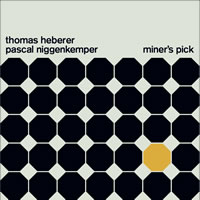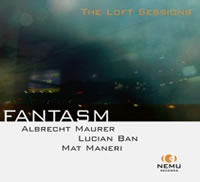Moment's Notice
Reviews of Recent Recordings
(continued)
Andrew Drury
Content Provider
Soup and Sound Recordings 50001
 Although somewhat less prolific than many of his peers, drummer Andrew Drury commands respect as both an improviser and composer, maintaining a busy schedule leading and collaborating in numerous ensembles, as well as teaching percussion workshops. A former student of Ed Blackwell, Drury’s longstanding work as a sideman to violinist Jason Kao Hwang and as a member of the power trio Totem> (with guitarist Bruce Eisenbeil and bassist Tom Blancarte) are two pertinent examples of his exceptional dexterity behind a trap set. As a composer, he reveals a fondness for oblique angles, extreme tonalities and unconventional structures, tempered by an awareness of tuneful song forms that provides an entryway into his idiosyncratic aesthetic.
Although somewhat less prolific than many of his peers, drummer Andrew Drury commands respect as both an improviser and composer, maintaining a busy schedule leading and collaborating in numerous ensembles, as well as teaching percussion workshops. A former student of Ed Blackwell, Drury’s longstanding work as a sideman to violinist Jason Kao Hwang and as a member of the power trio Totem> (with guitarist Bruce Eisenbeil and bassist Tom Blancarte) are two pertinent examples of his exceptional dexterity behind a trap set. As a composer, he reveals a fondness for oblique angles, extreme tonalities and unconventional structures, tempered by an awareness of tuneful song forms that provides an entryway into his idiosyncratic aesthetic.
Content Provider is his most recent ensemble, a bass-less quartet fronted by two imposing saxophonists: Briggan Krauss on alto and Ingrid Laubrock on tenor; with guitar wizard Brandon Seabrook serving as Drury’s rhythm section partner. The leader’s bottom-heavy approach to his kit and Seabrook’s measured contributions compensate for the lack of bass, while the horns add occasional counter lines of their own.
The self-titled debut of Drury’s four-piece is a quixotic fusion of expressionistic free jazz and edgy post-rock. Seamlessly integrating composed and improvised sections, the album’s six original compositions explore myriad textural intricacies within non-linear harmonic foundations. Krauss’ acerbic alto and Laubrock’s burly tenor interpret Drury’s vertiginous themes, staccato lines and dissonant drones with rhapsodic fervor, complementing notated material with bristling solos and thorny call-and-response interplay.
Seabrook is mostly relegated to a supportive role in this group, contributing an undercurrent of arpeggiated chords and hypnotic single-note refrains. There are moments where he strays however, punctuating tunes like “Keep the Fool” and the ceremonial title track with blistering bursts of virtuosic fingerpicking that elevate the bandstand. As demonstrated here and on recent releases by artists like Ben Allison, Mostly Other People Do the Killing and Vinnie Sperrazza, Seabrook has proven to be one of the most ingenious and talented guitarists of his generation.
Drury adroitly underscores these rarefied tunes without falling into predictable patterns, relying on color and dynamics more than standard timekeeping devices to keep the music engaging – especially on a bluesy reading of Clifford Brown’s buoyant bop classic “Daahoud.” Despite Drury’s relatively limited discography as a leader, Content Provider serves as an intriguing link between his heavily amplified debut, Polish Theater Posters (Red Toucan, 1998) and his last concerted effort as a bandleader, the all-acoustic sextet recording A Momentary Lapse (Innova, 2003).
–Troy Collins
lll人
Gjērhan
Otoroku ROKU011
 There’s more than a hint of impenetrability about this LP, from the solid dark grey of its cover and the cryptic credits in small red print (with cross-outs) in English and Japanese (the inner sleeve is a riot of abstract forms in vivid color) to the symbol that serves as a band name (a promo sheet reveals it’s pronounced “el” [actually /el/] without translating or explaining it or the title Gjērhan). There are no identifying marks on the spine, suggesting that once filed in a large collection it might never be found again, or if available in a record store it could be filed with a few Prince records from the years when he identified himself by a symbol.
There’s more than a hint of impenetrability about this LP, from the solid dark grey of its cover and the cryptic credits in small red print (with cross-outs) in English and Japanese (the inner sleeve is a riot of abstract forms in vivid color) to the symbol that serves as a band name (a promo sheet reveals it’s pronounced “el” [actually /el/] without translating or explaining it or the title Gjērhan). There are no identifying marks on the spine, suggesting that once filed in a large collection it might never be found again, or if available in a record store it could be filed with a few Prince records from the years when he identified himself by a symbol.
lll人 is a free-improvising London-based trio made up of Daichi Yoshikawa performing feedback with objects, Paul Abbott on drums and Seymour Wright on alto saxophone. Each side of the LP consists of a 20-minute piece. It’s the kind of music that some people like to call “uncompromising.” though I’m never sure quite what that means or what kind of compromise might be involved (or just who the compromising parties down the road might be, imagining anyone from Andy Williams to Peter Brötzmann). I prefer to think of it as music concerned with an authentic and immediate expression, a music committed to the onerous and impossible yet necessary task of cleansing itself of rhetoric. As such it’s definitely music at a cutting edge and it might stay there for some time. Whenever I hear music by Wright (early recordings with Eddie Prévost and various Matchless ensembles; the solo recording Seymour Wright of Derby; the duets with Nate Wooley, About Trumpet and Saxophone), it seems to insist on a new way of listening and a new way of writing about music.
While Wright’s voice on alto saxophone varies, it frequently resembles a choked scream. It’s Yoshikawa’s special talent to make feedback sound very much like this, to such a degree that the two voices actually fuse in a kind of tuning process, as if achieving identity is a key part of the process. Abbott’s scrabbling rolls on high-pitched drums complement this, often operating in the same narrow pitch range the other two favor. These processes are apparent on the second piece, “Fukushima” (a rare programmatic hint) as on the first, “Intersect” (which seems more like a methodological generality).
The music moves along consistently thoughtfully as a kind of three-way dialogue, sometimes giving way to monologues (sometimes simultaneous ones), as if there’s a gap between its raw, harsh, immediate timbres and a certain deliberation in the construction of lines. In that gap a listener might construct time, the present or a kind of personal silence.
–Stuart Broomer
Thomas Heberer + Pascal Niggenkemper
Miner’s Pick
FMR 383-0714
 Graham Haynes once said, “You can’t really rip through the cornet like a trumpet – play fast, high, breathy – ‘cause the air gets trapped in a different way, almost like a flugelhorn, especially with that shepherd’s crook. It has bite like a trumpet but it’s mellow like a flugelhorn. A lot of trumpeters try to get a cornet sound and don’t know it, a sound that's dark, not typically high-end brassy.”
Graham Haynes once said, “You can’t really rip through the cornet like a trumpet – play fast, high, breathy – ‘cause the air gets trapped in a different way, almost like a flugelhorn, especially with that shepherd’s crook. It has bite like a trumpet but it’s mellow like a flugelhorn. A lot of trumpeters try to get a cornet sound and don’t know it, a sound that's dark, not typically high-end brassy.”
Exactly.
A few years ago, to expand his expressive range, trumpeter Thomas Heberer took up a quarter-tone model with an extra valve. It got him into some new cracks, but he kept searching. Then one day he picked up a cornet and found what he had been looking for. The stubbier horn makes his prodigious wide leaps sound understated rather than boastful; it tempers his high notes and ripens his lows. (And so he joined the cornet club, with Haynes, Eric Boeren, Bobby Bradford, Olu Dara, Kirk Knuffke, Rob Mazurek, Ron Miles, Warren Vaché ...)
Heberer, member of the ICP Orchestra since the mid-‘90s, has put out diverse projects of his own since then. Pertinent to Miner’s Pick are his long-running duo with bassist Dieter Manderscheid back in Köln, and – since Thomas moved to New York – two trios with ex-Köln bassist Pascal Niggenkemper, HNH and Heberer’s graphic-score oriented Clarino.
The present duo improvises in the conversational style quaintly known to some as “non-idiomatic” – characterizing a style as a non-style. Better to call it idiosyncratic; there are some particular defining tendencies. Often Heberer deploys sung/blown multiphonics and circular breathing, sometimes both at once, a complex maneuver – you can’t sing straight through the breathing cycle, so his humming is discontinuous, long notes fading in and out under droning horn, in slow rhythm. He’ll sing a note on or just off cornet’s pitch, for a cavernous doubled sound or frictive resistance.
That said, the cornetist is too much of a melodist not to string together lyrical sequences; at one point he even catches himself quoting “Con Alma.” A ballad erupts toward the end of “47,” and a pealing tune surfaces quickly on “The Lion Cavern,” as arco bass prowls like a cat in the background.
Pascal Niggenkemper may engage in antic pizzicato thrumbling a la Wilbert de Joode, and he likes complex timbres. On “47” he places objects on the bridge to make the strings rattle like an mbira; on “Diabolite” he pulls strings around the side of the neck a la Mingus, for squawky vocalizations and (via sheer persistence) mbira momentum. He is also fond of the bow. Where some bassists get a good arco sound and stick with it (think Paul Chambers’ reliably leathery tone), Niggenkemper gets a rainbow of bowed timbres: soft murmurs, bee-swarms, medieval drones, leviathan groans. Strategically, he’s textural and linear by turns, an independent voice unbeholden to bass custom.
Typically each gives the other ample space and time to make a statement, to the point where they may play past each other without mishap. But not always. “Topaz Mountain” is all overt interaction, each quickly responding to timbral shifts. “Black Powder” is as close as they come to a fast swinger, but not so close. Niggenkemper never falls into a jazz 4/4 – in this open context, it’d sound like style quotation, putting on someone else’s hat. They move on their own terms.
Like other recordings of “difficult music,” these 10 performances may go down easier in larger rather than smaller doses. A handful at a time makes it easier to catch the duo’s idiosyncratic momentum. It gives you time to tune in.
–Kevin Whitehead
Rudresh Mahanthappa
Bird Calls
ACT Music ACT 9581-2
 Rather than delving further into his Indian roots, as was the case on Gamak, his electrifying 2013 release for ACT Music, Rudresh Mahanthappa draws upon the seminal efforts of the legendary Charlie Parker for inspiration on Bird Calls. The alto saxophonist employs a classic all-acoustic ensemble configuration to reinterpret and rework the very foundations of bebop, in an effort to demonstrate how forward-thinking Bird’s innovative concepts were over a half century ago.
Rather than delving further into his Indian roots, as was the case on Gamak, his electrifying 2013 release for ACT Music, Rudresh Mahanthappa draws upon the seminal efforts of the legendary Charlie Parker for inspiration on Bird Calls. The alto saxophonist employs a classic all-acoustic ensemble configuration to reinterpret and rework the very foundations of bebop, in an effort to demonstrate how forward-thinking Bird’s innovative concepts were over a half century ago.
Young trumpet prodigy Adam O’Farrill joins Mahanthappa on the frontline, while the sterling rhythm section consists of rising pianist Matt Mitchell, longstanding bassist François Moutin and critically-acclaimed drummer Rudy Royston. Although none of the pieces included on the album are actual covers, all are inspired by Parker’s familiar melodies or iconic solo improvisations to some degree. Mahanthappa updates Parker’s time-honored vernacular with post-modern invention, crafting an urbane language that sounds strangely familiar, yet utterly contemporary.
The lilting swing of “Maybe Later” is a primary example of this heady approach; although based on Parker’s famous solo from “Now’s the Time,” Mahanthappa changes the actual notes, but maintains the original tempo, honoring Parker’s rhythmic ingenuity in the process. The quicksilver “Both Hands” similarly reconfigures the melody of “Dexterity” by removing all of the rests, yielding a frenzied modernistic rendition that merely suggests its venerable origins. Not all of the album’s inclusions are blistering post-bop fare however. “Talin is Thinking” preserves the familiar melody of “Parker’s Mood,” but eschews rhythmic syncopation, transforming the dynamic theme into a sly, serpentine dirge. The harmonic changes of “Confirmation” provide a similar basis for the original melody of “Sure Why Not?,” a lush ballad.
Throughout the date Mahanthappa and O’Farrill spar and feint with the same impetuous vitality that Bird and Diz did decades ago; though the modulating time signatures and layered polyphony of “On the DL” only vaguely recall a deconstructed “Donna Lee,” the duo’s interweaving lines and breakneck pace keenly match their forbearers’ venturesome spirit. Moutin and Royston supply an array of shifting patterns and bold interpolations, while Mitchell’s standardized harmonies offer fascinating counterpoint to the horns’ polytonal voicings. A numbered series of titular soliloquies (“Bird Calls” 1 through 5) serve as thematic transitions between quintet tracks, enabling each member to interpret the material in unaccompanied fashion.
In addition to being one of his earliest influences on alto, Parker was Mahanthappa’s primary inspiration to become a working musician. According to Mahanthappa, “I think hearing Charlie Parker was what planted the first seeds of wanting to do this for the rest of my life.” Issued on the 95th anniversary of Parker’s birth, Bird Calls is far more than a mere tribute, it is a highly personalized and thrillingly vibrant homage to the continuing legacy of one of the most significant musicians of the past century.
–Troy Collins
Albrecht Maurer + Lucian Ban + Mat Maneri
Fantasm: The Loft Sessions
Nemu 15
 For long spells, Fantasm feels like something perfect, a masterwork of mood and nuance and microscopic melodic development. I’m not suggesting it’s flawless; that’s not really the point. Violinist Albrecht Maurer, violist Mat Maneri, and pianist Lucian Ban are expert travelers on the musical margins – out near the edges, between workaday intervals and routine harmonic obligations. There are jarring, pointillistic flurries. There are lines that remain perpetually out of sync. We’re rooted somewhere between jazz, open forms, and a contemporary classical aesthetic. Fantasm is an extraordinary record.
For long spells, Fantasm feels like something perfect, a masterwork of mood and nuance and microscopic melodic development. I’m not suggesting it’s flawless; that’s not really the point. Violinist Albrecht Maurer, violist Mat Maneri, and pianist Lucian Ban are expert travelers on the musical margins – out near the edges, between workaday intervals and routine harmonic obligations. There are jarring, pointillistic flurries. There are lines that remain perpetually out of sync. We’re rooted somewhere between jazz, open forms, and a contemporary classical aesthetic. Fantasm is an extraordinary record.
Six years ago this trio was embedded in Enesco Re-Imagined, Ban and bassist John Hebert’s third-stream octet concerned with the music of 20th century Romania composer George Enesco. In 2013 Ban and Maneri released Transylvanian Concert (ECM), a far-reaching series of duos – improvisations, spirituals, new music, and the blues. Live, Maurer was added early on. Fantasm, recorded in Cologne in May 2012 and ‘13, comes from these dates.
Fantasm’s basic roadmap includes every possible three-piece variation: trio, solo, duet. Each combination quietly unfurls; from the start, this tiny configuration feels shorn of restrictions. The two-string effect (viola, violin) is marvelous and Maneri’s and Maurer’s deep comfort with microtonal realities adds another dimension.
The original pieces – Ban supplies five, Maurer two, Maneri one – are crucial starting points. But the disc takes its name from a 1981 Paul Motian composition. Maneri is a onetime colleague of the late drummer; this might be a simple tip-of-the-cap to a mentor. But it somehow feels like more than that. Motian’s aesthetic seems to be a shaping force – the drummer’s preternatural sense of space and line, his example of how voices can be woven into an ensemble. Even when moments of Fantasm felt informed by a particular tradition – the baroque, folk melody, and, in Ban’s case, Keith Jarrett – the overarching spirit kept tugging me back to the album’s title, and to everything it implies.
Still, these three remain their own men. Fantasm is inspired forward-thinking music. By the end of the year I suspect it will be one of the highlights of 2015.
–Greg Buium
